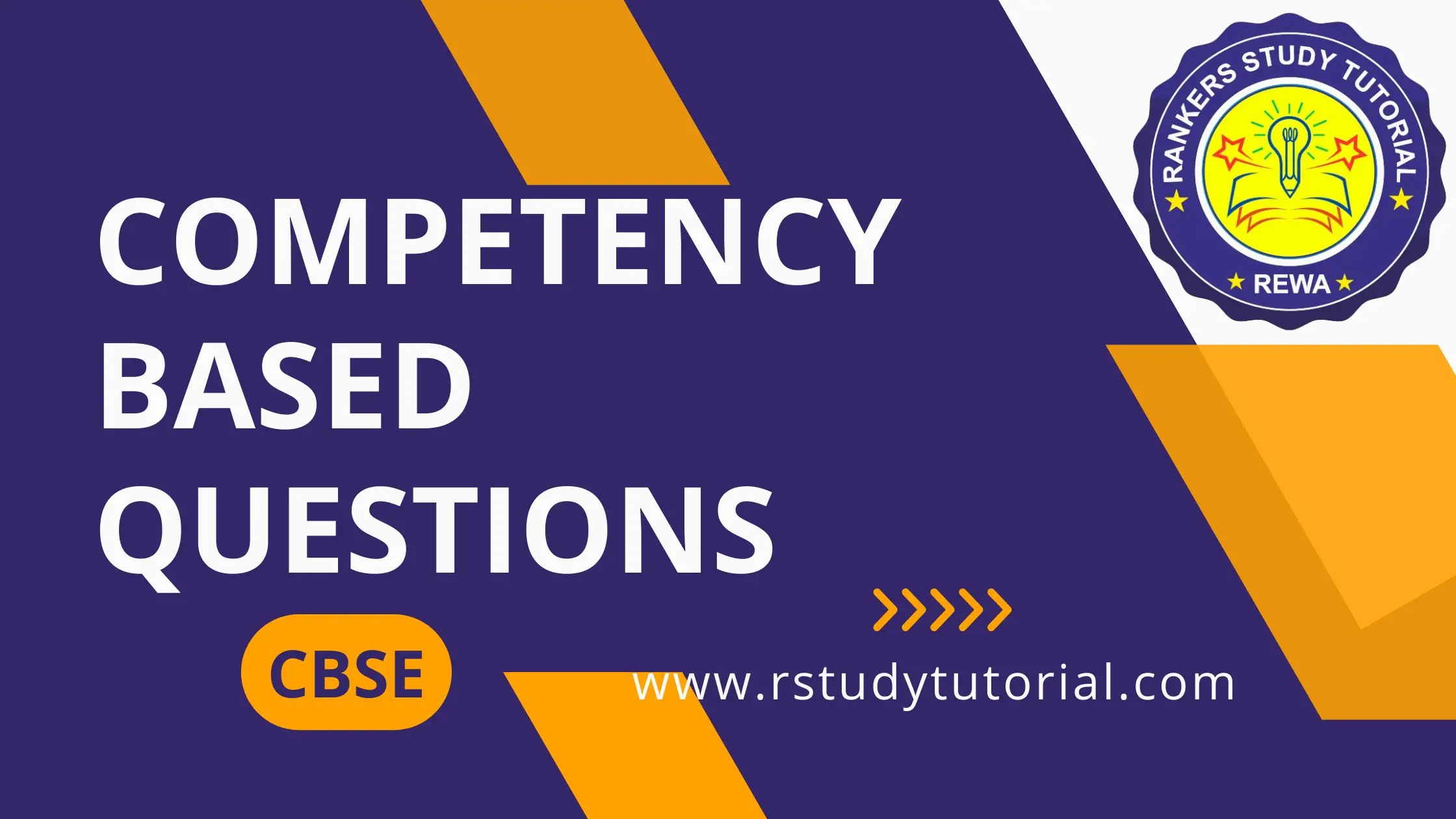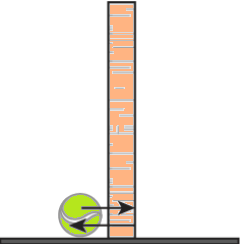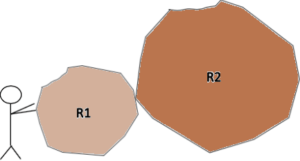Hint: Interpret data to identify uniform and non-uniform motion of an object.
Question.1. The image shows a distance time graph of a train’s journey.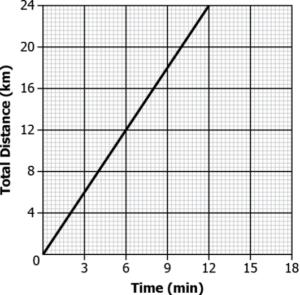
(a) uniform motion
(b) non-uniform motion
(c) constant retardation
(d) constant acceleration
Question.2. A student practicing for the hurdle race puts 4 hurdles A, B, C and D at equal distance on a straight track as shown in the image.
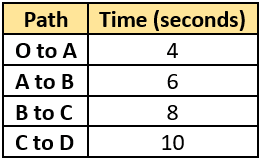
(a) uniform motion because the student is travelling in a same direction from O to D
(b) non-uniform motion because the student is moving over four hurdles between O and D
(c) uniform motion because the time difference between two consecutive paths is equal
(d) non-uniform motion because the student covers equal distance at unequal intervals of time
Ans.1. (a) uniform motion
Ans.2. (d) non-uniform motion because the student covers equal distance at unequal intervals of time
Hint: Examine forces acting on a body in order to determine change in body’s motion as a consequence of resultant force.
Question.3. The image shows the forces acting on a block. The length of the arrow shows the strength of the force and the direction of the arrow shows the direction of application of the force.
(a) upwards
(b) downwards
(c) towards left
(d) towards right
Question.4. A force of 10 N is acting on a block towards the left, if the force of 15 N is acting towards the right. How much net force is acting on the object?
(a) 5 N towards left
(b) 5 N towards right
(c) 25 N towards left
(d) 25 N towards right
Ans.3. (d) towards right
Ans.4. (b) 5 N towards right
Hint: Determine the impact of frictional force on the motion of an object.
Question.5. A block is at rest on a table. A girl applies a force towards the right. The applied force is equal to the frictional force between block and the surface. What will happen to the block?
(a) it starts rotating
(b) it does not move
(c) it will start sliding towards left
(d) it will start sliding towards right
Question.6. Two boys X and Y push a block in directions shown in the image.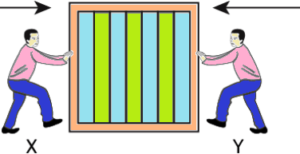
(a) downward to the ground
(b) upwards towards the block
(c) opposite to the force applied by X
(d) opposite to the force applied by Y
Ans.5. (b) it does not move
Ans.6. (c) opposite to the force applied by X
Hint: Identify examples and situations that illustrate the use of Newton’s first Law of motion and Inertia.
Question.7. Which of the given example can be illustrated using the Newton’s first law of motion?
(a) rowing of boat
(b) rocket propulsion
(c) wearing a seat belt in a car
(d) releasing an arrow from bow
Question.8. A tennis ball and a bowling ball are kicked with the same force; which option relates the distance travelled by the balls to the inertia of the balls?
(a) tennis ball moves farther than bowling ball because it has less inertia
(b) tennis ball moves farther than bowling ball because it has high inertia
(c) bowling ball moves farther than tennis ball because it has less inertia
(d) bowling ball moves farther than tennis ball because it has high inertia
Ans.7. (c) wearing a seat belt in a car
Ans.8. (a) tennis ball moves farther than bowling ball because it has less inertia
Hint: Calculate the momentum of objects when two bodies collide.
Question.9. A ball of 150 g is hit with a bat; the ball starts travelling with a velocity of 3 m/s. What is the momentum of the ball?
(a) 0.05 kg m/s
(b) 0.45 kg m/s
(c) 50 kg m/s
(d) 450 kg m/s
Question.10. A bullet of mass 0.020 kg is fired; it strikes the wooden block of 0.50 kg and sticks in it. The bullet and wooden block move off together with a velocity of 100 m/ s. What is the momentum of the bullet with wooden block?
(a) 2 kg m/s
(b) 50 kg m/s
(c) 52 kg m/s
(d) 70 kg m/s
Ans.9. (b) 0.45 kg m/s
Ans.10. (c) 52 kg m/s
Hint: Apply Newton’s Second Law of Motion and calculate rate of change of momentum in objects.
Question.11. A marble of mass “m” at rest is pushed with force “F”, it starts travelling with velocity “v” in time “t”. Which option correctly relates the force with change in omentum?
(a) F= (mv.t)
(b) F= (mv/t)
(c) F= (move)/t
(d) F= (move/t)
Question.12. The image shows the forces acting on the car.
(a) car is at rest
(b) car is accelerating
(c) car is slowing down
(d) car is moving with a constant velocity
Ans.11. (b) F= (mv/t)
Ans.12. (d) car is moving with a constant velocity
Hint: Interpret SI unit of force and use formulas to calculate mass of an object.
Question.13. The SI unit for force does not contain which of the following physical quantitates?
(a) Quantity
(b) Length
(c) Time
(d) Luminosity
Question.14. Earth pulls objects towards it due to gravity. If the force applied by the earth on an apple is 100 Newtons, what is the mass of the apple, given the acceleration that apple undergoes is 10 m/s^{2}?
(a) 5
(b) 10
(c) 15
(d) 20
Ans.13. (d) Luminosity
Ans.14. (d) 20
Hint: Illustrate Newton’s Third Law of Motion.
Question.15. A cricket ball strikes the wall; which option shows the correct pair of forces acting on the ball?
(a) 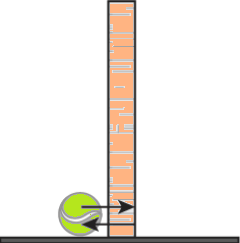
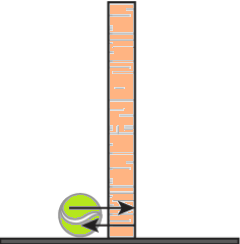
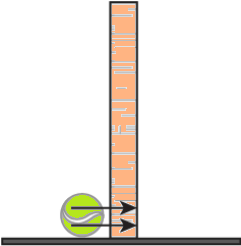
Question.16. A block X of mass “m” strikes another block Y of mass “2m”. Both the blocks collide and at point of collision the block X exerts the force of 10 N to block Y. What will be the size and direction of the force exerted by block Y?
(a) 10 N, in the same direction of force of block X
(b) 20 N, in the same direction of force of block X
(c) 10 N, opposite to the direction of force of block X
(d) 20 N, opposite to the direction of force of block X
Ans.15. (a) 
Hint: Identify situations that demonstrate the application of Newton’s third Law of Motion.
Question.17. According to the third law of motion, every object acted upon by an external force applies an equal force in opposite direction. Which of the following phenomenon is best described by this law?
(a) Recoil when a gun is fired
(b) Engine thrust produced by rockets
(c) An apple kept on the desk motionless
(d) All of the above
Question.18. A person pushes a rock, R1, to the right while pushing another rock, R2, that is heavier than R1. The total mass of R2 is three times the total mass of R1. If the person is pushing with enough force that the two rocks accelerate to the right, what can be said for sure about the magnitudes of the forces on the rocks?
(a) The force on R2 exerted by R1 is larger in magnitude than the force on R1 exerted by R2
(b) The force on Cart 2 exerted by Cart 1 is smaller in magnitude than the force on Cart 1 exerted by Cart 2.
(c) The force on Cart 2 exerted by Cart 1 is equal in magnitude to the force on Cart 1 exerted by Cart 2
(d) The force on Cart 2 exerted by Cart 1 could be larger or smaller depending on the size of the acceleration.
Ans.17. (d) All of the above
Ans.18. (c) The force on Cart 2 exerted by Cart 1 is equal in magnitude to the force on Cart 1 exerted by Cart 2
Hint: Calculate momentum of bodies before and after a collision (when no external
force is applied), and thus apply and derive law of conservation of momentum.
Question.19. A Ball A of mass m_{1} travelling with a velocity u_{1} collides with another Ball B of mass m_{2} at rest. After collision the velocity of Ball A changes to v_{1} and velocity of Ball B changes to v_{2}. If the momentum is conserved, which option correctly relates the momentum before and after the collision?
(a) (m_{1}.u_{1})+(m_{1}.v_{1})=(m_{2}.v_{2})
(b) (m_{1}.u_{1})=(m_{1}.v_{1})+(m_{2}.v_{2})
(c) (m_{2}.v_{2})-(m_{1}.u_{1})=(m_{1}.v_{1})
(d) (m_{1}.u_{1})=(m_{1}.v_{1})-(m_{2}.v_{2})
Question.20. A boy of mass 40 kg jumps out of a boat of 200 kg on the bank, with a velocity of 2 m/s. If the momentum is conserved. With what velocity the boat will move backwards?
(a) 0.4 m/s
(b) 0.8 m/s
(c) 5 m/s
(d) 10 m/s
Ans.19. (b) (m_{1}.u_{1})=(m_{1}.v_{1})+(m_{2}.v_{2})
Ans.20. (a) 0.4 m/s

